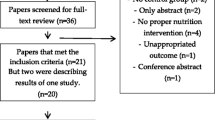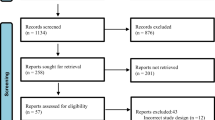Abstract
Objectives
The aim of this systematic review is to provide an overview of the efficacy of different exercise interventions to counter sarcopenia in older adults. This review will allow the Belgian Society of Gerontology and Geriatrics and other scientific societies to formulate specific exercise recommendations in their Clinical Guidelines for Sarcopenia.
Design
We used the method of a systematic umbrella-review. Based on the level of evidence, we formulated specific recommendations for clinical practice.
Methods
Two databases (Pubmed and Web Of Science) were searched systematically and methodological quality of the reviews was assessed. Extracted data was than mapped to an exercise category and an overall synthesis (bottom line statements) was formulated for each of these exercise categories. Subsequently, we assigned a rating of the quality of the evidence supporting each bottom line statement.
Results
We identified 14 systematic reviews or meta-analyses, encompassing four exercise categories: resistance training, resistance training + nutritional supplementation, multimodal exercise programmes and bloodflow restriction training. Importantly, very few systematic reviews or meta-analyses clearly mentioned baseline sarcopenia status. There is high quality evidence for a positive and significant effect of resistance training on muscle mass, muscle strength, and physical performance. The added effect of nutritional supplementation for resistance training on muscle function appears limited. Blood flow restriction training is a novel training method that has a significant impact on muscle strength.
Conclusion
Since sarcopenia is affecting all skeletal muscles in the body, we recommend training the large muscle groups in a total body approach. Although low-intensity resistance training (≤50% 1RM) is sufficient to induce strength gains, we recommend a high-intensity resistance training program (i.e. 80% 1RM) to obtain maximal strength gains. Multimodal exercises and blood flow restriction resistance training may be considered as well.



Similar content being viewed by others
References
Rosenberg, I.H., Sarcopenia: origins and clinical relevance. J Nutr, 1997;127(5 Suppl): p. 990s–991s.
Cruz-Jentoft, A.J., et al., Sarcopenia: European consensus on definition and diagnosis: Report of the European Working Group on Sarcopenia in Older People. Age Ageing, 2010;39(4): p. 412–23.
Cruz-Jentoft, A.J., et al., Sarcopenia: revised European consensus on definition and diagnosis. Age Ageing, 2018: p. afy169-afy169.
Fielding, R.A., et al., Sarcopenia: an undiagnosed condition in older adults. Current consensus definition: prevalence, etiology, and consequences. International working group on sarcopenia. J Am Med Dir Assoc, 2011;12(4): p. 249–56.
Dent, E., et al., International Clinical Practice Guidelines for Sarcopenia (ICFSR): Screening, Diagnosis and Management. 2018.
Dam, T.-T., et al., An Evidence-Based Comparison of Operational Criteria for the Presence of Sarcopenia. The Journals of Gerontology Series A: Biological Sciences and Medical Sciences, 2014;69(5): p. 584–590.
Studenski, S.A., et al., The FNIH sarcopenia project: rationale, study description, conference recommendations, and final estimates. J Gerontol A Biol Sci Med Sci, 2014;69(5): p. 547–58.
Anker, S.D., J.E. Morley, and S. von Haehling, Welcome to the ICD-10 code for sarcopenia. J Cachexia Sarcopenia Muscle, 2016;7(5): p. 512–514.
Lauretani, F., et al., Identification and treatment of older persons with sarcopenia. Aging Male, 2014;17(4): p. 199–204.
De Spiegeleer, A., et al., Pharmacological Interventions to Improve Muscle Mass, Muscle Strength and Physical Performance in Older People: An Umbrella Review of Systematic Reviews and Meta-analyses. Drugs Aging, 2018.
Liberati, A., et al., The PRISMA statement for reporting systematic reviews and meta-analyses of studies that evaluate healthcare interventions: explanation and elaboration. Bmj, 2009;339: p. b2700.
Ouzzani, M., et al., Rayyan-a web and mobile app for systematic reviews. Syst Rev, 2016;5(1): p. 210.
Higgins JPT, G.S.e., Cochrane Handbook for Systematic Reviews of Interventions Version 5.1.0 [updated March 2011]. 2011, The Cochrane Collaboration.
Shea, B.J., et al., Development of AMSTAR: a measurement tool to assess the methodological quality of systematic reviews. BMC Med Res Methodol, 2007;7: p. 10.
Austin, T.M., R.R. Richter, and C.A. Sebelski, Introduction to the GRADE Approach for Guideline Development: Considerations for Physical Therapist Practice. Phys Ther, 2014.
Antoniak, A.E. and C.A. Greig, The effect of combined resistance exercise training and vitamin D3 supplementation on musculoskeletal health and function in older adults: a systematic review and meta-analysis. BMJ Open, 2017;7(7): p. e014619.
Beaudart, C., et al., Nutrition and physical activity in the prevention and treatment of sarcopenia: systematic review. Osteoporosis International, 2017;28(6): p. 1817–1833.
Bibas, L., et al., Therapeutic interventions for frail elderly patients: part I. Published randomized trials. Prog Cardiovasc Dis, 2014;57(2): p. 134–43.
Borst, S.E., Interventions for sarcopenia and muscle weakness in older people. Age and Ageing, 2004;33(6): p. 548–555.
Buch, A., et al., Circuit resistance training is an effective means to enhance muscle strength in older and middle aged adults A systematic review and meta-analysis. Ageing Research Reviews, 2017;37: p. 16–27.
Csapo, R. and L.M. Alegre, Effects of resistance training with moderate vs heavy loads on muscle mass and strength in the elderly: A meta-analysis. Scandinavian Journal of Medicine & Science in Sports, 2016;26(9): p. 995–1006.
Hughes, L., et al., Blood flow restriction training in clinical musculoskeletal rehabilitation: a systematic review and meta-analysis. Br J Sports Med, 2017;51(13): p. 1003–1011.
Duplicate, et al., The effects of exercise on muscle strength, body composition, physical functioning and the inflammatory profile of older adults: a systematic review. Current Opinion in Clinical Nutrition and Metabolic Care, 2017;20(1): p. 30–53.
Martins, W.R., et al., Elastic resistance training to increase muscle strength in elderly: A systematic review with meta-analysis. Archives of Gerontology and Geriatrics, 2013;57(1): p. 8–15.
Papa, E.V., X. Dong, and M. Hassan, Resistance training for activity limitations in older adults with skeletal muscle function deficits: a systematic review. Clinical Interventions in Aging, 2017;12: p. 955–961.
Peterson, M.D., et al., Resistance exercise for muscular strength in older adults: A meta-analysis. Ageing Research Reviews, 2010;9(3): p. 226–237.
Peterson, M.D., A. Sen, and P.M. Gordon, Influence of resistance exercise on lean body mass in aging adults: a meta-analysis. Med Sci Sports Exerc, 2011;43(2): p. 249–58.
Theodorakopoulos, C., et al., Effectiveness of nutritional and exercise interventions to improve body composition and muscle strength or function in sarcopenic obese older adults: A systematic review. Nutrition Research, 2017;43: p. 3–15.
Yoshimura, Y., et al., Interventions for Treating Sarcopenia: A Systematic Review and Meta-Analysis of Randomized Controlled Studies. Journal of the American Medical Directors Association, 2017;18(6).
De Spiegeleer, A., et al., Pharmacological Interventions to Improve Muscle Mass, Muscle Strength and Physical Performance in Older People: An Umbrella Review of Systematic Reviews and Meta-analyses. Drugs Aging, 2018;35(8): p. 719–734.
Avenell, A., J.C.S. Mak, and D. O’Connell, Vitamin D and vitamin D analogues for preventing fractures in post-menopausal women and older men. Cochrane Database of Systematic Reviews, 2014(4).
Liberman, K., et al., The effects of exercise on muscle strength, body composition, physical functioning and the inflammatory profile of older adults: a systematic review. Curr Opin Clin Nutr Metab Care, 2017;20(1): p. 30–53.
WHO. World Health Organisation — Global recommendations on physical activity for health. 2010; Available from: http://www.who.int/dietphysicalactivity/factsheet_olderadults/en/ (last checked: 12/12/2018).
Chen, L.K., et al., Sarcopenia in Asia: consensus report of the Asian Working Group for Sarcopenia. J Am Med Dir Assoc, 2014;15(2): p. 95–101.
Beaudart, C., et al., Prevalence of sarcopenia: the impact of different diagnostic cut-off limits. J Musculoskelet Neuronal Interact, 2014;14(4): p. 425–31.
Beaudart, C., et al., Estimation of sarcopenia prevalence using various assessment tools. Exp Gerontol, 2015;61: p. 31–7.
Moher, D., et al., Preferred reporting items for systematic reviews and meta-analyses: the PRISMA statement. PLoS Med, 2009;6(7): p. e1000097.
Buch, A., et al., Circuit resistance training is an effective means to enhance muscle strength in older and middle aged adults A systematic review and meta-analysis. Ageing Research Reviews. 37: p. 16–27.
Csapo, R. and L.M. Alegre, Effects of resistance training with moderate vs heavy loads on muscle mass and strength in the elderly: A meta-analysis. Scand J Med Sci Sports. 26(9): p. 995–1006.
Theodorakopoulos, C., et al., Effectiveness of nutritional and exercise interventions to improve body composition and muscle strength or function in sarcopenic obese older adults: A systematic review. Nutrition Research. 43: p. 3–15.
Yoshimura, Y., et al., Interventions for Treating Sarcopenia: A Systematic Review and Meta-Analysis of Randomized Controlled Studies. Journal of the American Medical Directors Association. 18(6).
Borst, S.E., Interventions for sarcopenia and muscle weakness in older people. Age Ageing, 2004;33(6): p. 548–55.
Peterson, M.D., et al., Resistance exercise for muscular strength in older adults: a meta-analysis. Ageing Res Rev, 2010;9(3): p. 226–37.
Papa, E.V., X.Y. Dong, and M. Hassan, Resistance training for activity limitations in older adults with skeletal muscle function deficits: a systematic review. Clinical Interventions in Aging, 2017;12: p. 955–961.
Beaudart, C., et al., Nutrition and physical activity in the prevention and treatment of sarcopenia: systematic review. Osteoporosis International. 28(6): p. 1817–1833.
Antoniak, A.E. and C.A. Greig, The effect of combined resistance exercise training and vitamin D-3 supplementation on musculoskeletal health and function in older adults: a systematic review and meta-analysis. Bmj Open. 7(7).
Liberman, K., et al., The effects of exercise on muscle strength, body composition, physical functioning and the inflammatory profile of older adults: a systematic review. Current Opinion in Clinical Nutrition and Metabolic Care. 20(1): p. 30–53.
Hughes, L., et al., Blood flow restriction training in clinical musculoskeletal rehabilitation: a systematic review and meta-analysis. Br J Sports Med. 51(13): p. 1003–1011.
Author information
Authors and Affiliations
Consortia
Corresponding author
Additional information
Members of the Sarcopenia Guideline Development group of the BSGG: Ivan Bautmans; ivan.bautmans@vub.be; Charlotte Beaudart; c.beaudart@ulg.ac.be; David Beckwée; david.beckwee@vub. be; Ingo Beyer; Ingo.Beyer@uzbrussel.be; Olivier Bruyère; olivier.bruyere@ulg.ac.be; Sandra De Breucker; Sandra.De.Breucker@erasme. ulb.ac.be; Anne-Marie De Cock; Annemarie.DeCock@emmaus.be; Andreas Delaere; Andreas.Delaere@vub.be; Marie de Saint-Hubert; marie.desainthubert@uclouvain.be; Anton De Spiegeleer; Anton.DeSpiegeleer@UGent.be; Evelien Gielen; evelien.gielen@ uzleuven.be; Stany Perkisas; stany.perkisas@zna.be; Maurits Vandewoude; Maurits. Vandewoude@zna.be
Electronic supplementary material
Rights and permissions
About this article
Cite this article
Beckwée, D., Delaere, A., Aelbrecht, S. et al. Exercise Interventions for the Prevention and Treatment of Sarcopenia. A Systematic Umbrella Review. J Nutr Health Aging 23, 494–502 (2019). https://doi.org/10.1007/s12603-019-1196-8
Received:
Accepted:
Published:
Issue Date:
DOI: https://doi.org/10.1007/s12603-019-1196-8




